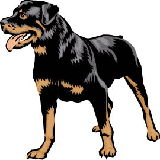Big DogsInformation About The Rhodesian Ridgeback Dog Breed |
|
|
istory and origin : It is believed that Great Danes, Mastiffs, Bloodhounds, and perhaps Greyhounds were interbred to produce this breed. The Rhodesian Ridgeback was developed in South Africa in the 18 th century and was used to hunt big game over vast areas in extreme temperatures. This dog could go for long periods without water. With the help of his excellent vision and sense of smell, this breed could detect the approach of either animal or human. Description : The Rhodesian Ridgeback stands 24 to 27 inches at the shoulder and weighs between 65 and 85 pounds. He has a large, powerful, well-muscled body, long and uncropped tail, and a short, stiff, shedding coat with a characteristic ridge of hair on his back that grows in the opposite direction and seems to have no function. The coat requires regular brushing. The color is always a reddish brown, sometimes with white patches on the chest and feet. About the breed : The Rhodesian Ridgeback got his name from the line of hair shaped like a blade of a broadsword and grows in the reverse direction along the back, with two crowns at the shoulder and the point towards the tail. He is a muscular dog of the hound group, with characteristics of both a sight hound and a scent hound. He is independent, active, often dominant and stubbornly driven, and yet curiously sensitive. This breed is affectionate with his owners, good with children, and may be suspicious of strangers. His has an excellent sense of smell and makes an excellent watchdog. This is a strong breed that needs obedience training from day one. The method must be firm but not overbearing, or the dog may panic and become passive-resistant if pressed too hard. Slow, precise methods should be practiced. Socialization with people is very important because this breed can be aggressive if he feels threatened. Also keep in mind that the Rhodesian Ridgeback was bred to challenge lions, leopards, and hyenas, and may therefore be dog-aggressive if not socialized with other dogs from puppy hood. Neutering the males will help reduce this problem especially if it is done before eight months of age. The females tend to be much more sensitive than the males and should be trained with a less demanding technique. Because of the Ridgeback's great size and power, this breed is not suitable for small children. However, he is good with children as long as there is no roughhousing. Do not buy two Rhodesian Ridgebacks from the same litter. Litter mates tend to bond closely with each other and will often openly disobey the owner in favor of pack loyalties. Feeding : Recommended feeding for this breed is 1 ½ - 2 ½ cans of branded dog food (13.3oz) supplemented by biscuit or 5 cupfuls of a complete dry food. Ideal home : A house with a yard is important, but do not leave this breed alone for long periods because he may be noisy and destructive, and he can jump a fence. The owner of a Rhodesian Ridgeback must be a firm leader who is consistent and patient. Pampering or spoiling may create a pushy dog that lacks confidence. Nervous, submissive, and overbearing people should avoid this breed. The elderly and the disabled should also consider a different breed. He needs regular exercise; joggers do well with the Rhodesian Ridgeback due to his tremendous endurance.Back to the Big Dog Breed article page
| |
|
Related News About Dogs ' ); // get rid of newsfeed display by carp CarpConf('poweredby',''); CarpCacheShow('http://classifieds.agriscape.com/syndicate/dogs.rss'); ?>
|
|
|
|
|
|
Copyright © 2006-2007 dogguidance.com |


